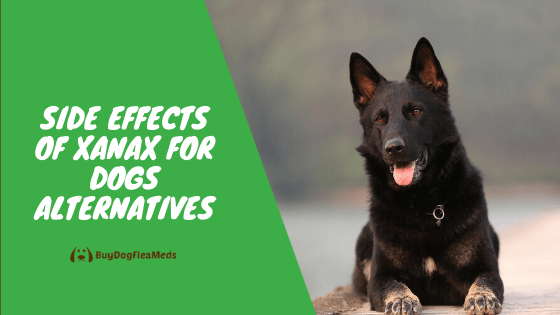Side Effects of Xanax For Dogs & Alternatives
What Is Xanax for Dogs?
Xanax, with the generic name of alprazolam, is a type of drug that belongs to the benzodiazepines category. It has been used in treating insomnia, panic attacks, withdrawal symptoms, seizures, and anxiety in humans. However, veterinarians have now adopted this medicine to help pets overcome aggression, seizures, and anxiety as well.
Since it’s under the group of benzodiazepines, Xanax is basically used to treat chemical and neurological imbalances inside the brain. It stimulates the brain to release chemicals called neurotransmitters that give a sedative effect. The calming properties it contains make it an effective solution to improve pet’s health conditions.
Dosage of Xanax
Essentially, the use of this controlled substance should be according to the prescription of a vet. Pets must undergo thorough examination before veterinarians can prescribe this drug. In addition, pet owners should provide a detailed history of their dogs’ health to ensure effective treatment and prevent overdose.
Proper administering of Xanax to dogs has a correct dosage to be followed. On average, this drug is prescribed between 0.005g milligram to 2 milligrams per pound. You have to consider the size and breed of your dog to determine the exact dosage needed. Medication is administered every 6 to 12 hours in order to achieve maximum results.
For treating panic and general anxiety, you can administer Xanax orally with a dosage of 0.005 to 0.045 milligram per pound, 0.12 to 0.9 milligram for separation anxiety (up to 3x daily), 0.01 to 0.18 milligram for storm anxiety every 4 hours, and 0.005 to 0.045 for phobias and night waking every 6 to 12 hours.
Keep in mind that this drug can be addictive, so it’s not recommended for long-term medication. This treatment also strictly requires the supervision of your veterinarian to avoid overdose and fatal side effects. Before your dog takes Xanax, the main cause of his anxiety must be determined to ensure effectiveness.
Side Effects of Xanax
Just like other drugs, there are also side effects of Xanax that you need to take note of. Here are some common signs to observe when giving your dog this type of anxiety treatment:
- increased appetite
- liver problems
- physical dependency (shaking, sensitivity, and vomiting)
- over-excitement
- aggressiveness
- clumsiness
- fatigue
Now, if your dog suffers from Xanax overdose, the signs to watch out for include confusion, slower reaction time, inability to do regular functions, and sedation wherein symptoms of unconsciousness are exhibited. This medication is not recommended for dogs with kidney/liver disease, glaucoma, and muscular weakness.
Xanax has an impact on the chemical balance of the brain, therefore affecting other systems including memory, reproduction, sleep cycles, and digestion. It’s important to consider that this medication for pets should be treated as the last resort after alternative treatments have been tried.
Cost of Xanax
The average cost of Xanax is $448 per bottle that contains 100 oral tablets (0.25 milligram per tablet). However, prices may vary, depending on where you buy it such as in local drugstores and online shops. You can buy the generic version as a cheaper option with the same effectiveness.
Since it’s an expensive drug for treating anxiety and seizures in dogs, you may look for discounts, promo codes, or coupons to save money. Generic alprazolam might also be covered by your insurance plan, so make sure to check it with your provider.
Interaction with Other Drugs
As a prescription drug, Xanax should only be administered to dogs when there’s a vet recommendation. To make sure it is the best treatment for your pet, your vet will determine the possible causes of your dog’s anxiety. In addition, other drugs will also be considered before giving this medication as it may interact with them and lead to bad reactions.
If you administer Xanax to your pet with antacids, it might slow down the absorption of the drug. Therefore, it’s important to separate the two if prescribed to be taken concurrently. Let the dog take the first medication and then follow it with the other after two hours.
Other drugs that may interact with the absorption of Xanax are propranolol, ketoconazole, itraconazole, erythromycin, and cimetidine. These drugs can increase sedition effects when taken with alprazolam. On the other hand, flumazenil can reverse all the effects of Xanax, which provides an excellent solution in case your dog suffers from drug overdose.
Digoxin medication can be more effective when taken with Xanax. However, there should be a close monitoring to avoid adverse effects. If you want to increase sedation, you can administer Xanax with CNS depressants such as barbiturates.
Ingredients in Xanax
The main ingredient of Xanax is alprazolam, a triazolo analog of 1,4 benzodiazepine group of active compounds for the central nervous system. Its chemical name is 8-Chloro-1-methyl-6-phenyl-4H-s-triazolo [4,3-a] [1,4] benzodiazepine.
The inactive ingredients in Xanax oral tablets are sodium benzoate, colloidal silicon dioxide, magnesium stearate, lactose monohydrate, sodium starch glycollate, povidone, docusate sodium, corn starch, and microcrystalline cellulose. They may also contain D&C Yellow No.10 and FD&C Yellow No.6.
Xanax Alternatives
Because of the usual side effects of synthetic medicines, natural remedies are still the best option for pets. You can use Anxietrex to reduce your dog’s anxiety without getting any awful side effects. Other treatments you can explore include special training to help your pet manage anxiety and depression.
There are online programs available for dogs with anxiety. They train pets to be more active so that they can overcome depressive episodes. As a result, dogs improve muscle strength, reduce panic attacks, aggression and other anxiety-related conditions.
But, if you’re looking for a 100% natural alternative to Xanax, CBD oil is an ideal option. This natural supplement has been proven effective in treating anxiety in dogs. Unlike other cannabis products, CBD oil doesn’t contain THC so there’s no need to worry about your dog getting “high”.
Furthermore, this natural alternative also stabilizes your dog’s mood while making him easy and relaxed. It decreases aggressiveness, anxiety, panic attacks, phobias, separation anxiety, depression, irritable bowel, seizures, and other conditions that your pet may be struggling with.
References
https://www.petcarerx.com/medication-guides/using-alprazolam-generic-xanax-for-dogs-and-cats/1372
https://www.veterinaryplace.com/dog-medicine/xanax-for-dogs/

